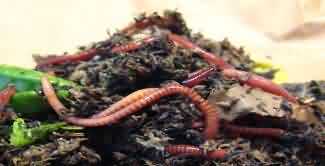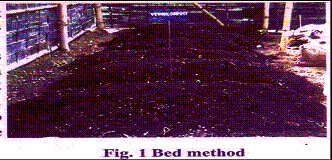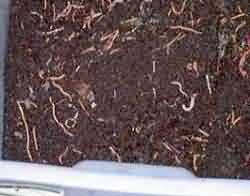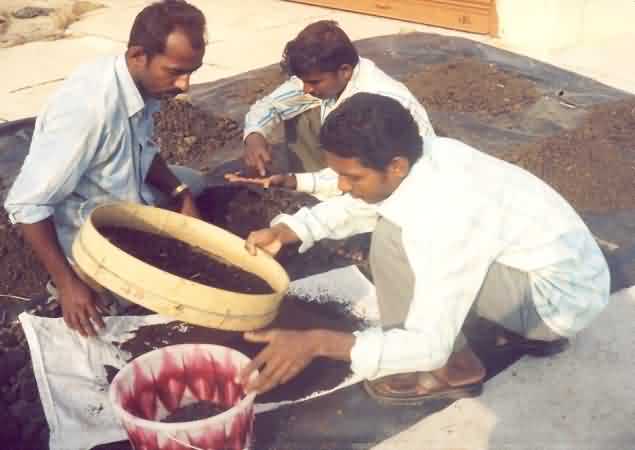वर्मीकम्पोस्ट - खाद या उर्वरकों की रानी
 Vermicompost is an organic manure (bio-fertilizer) produced as the vermicast by earth worm feeding on biological waste material; plant residues. Vermi casts are popularly called as 'Black gold'.
Vermicompost is an organic manure (bio-fertilizer) produced as the vermicast by earth worm feeding on biological waste material; plant residues. Vermi casts are popularly called as 'Black gold'.
This compost is an odorless, clean, organic material containing adequate quantities of N, P, K and several micronutrients essential for plant growth. Vermicompost is a preferred nutrient source for organic farming, which enriches soil quality by improving its physicochemical and biological properties.
It is eco-friendly, non-toxic, consumes low energy input for composting and is a recycled biological product.
Vermicompost is becoming popular as a major component of organic farming system.
Base materials required for Vermi composting:
Crop residues ,tree leaves and animal dung are the the basic materials required.Agricultural wastes like sugarcane trash,weeds hedge cuttings ,saw dust, coir waste,paddy husk, cattle dung, effluent slurry, from bio-gas plant, excreta of sheep, horse , pig, poultry droppings (in small quantity) and vegetable wastes are ideal food for earth worms.
City garbage or even biodegradable organic sludge, a waste product from ETP of any industry can also be used for feeding worms.
Selection of species:
There are different species of earthworms viz. Eisenia foetida (Red earthworm), Eudrilus eugeniae (night crawler), Perionyx excavatus etc. Red earthworm is preferred because of its high multiplication rate and thereby converts the organic matter into vermicompost within 45-50 days. Since it is a surface feeder it converts organic materials into vermicompost from top.
Methods of vermicomposting
Vermicromposting is done by various methods, among them bed and pit methods are more common.
Bed method :
Composting is done on the pucca / kachcha floor by making bed (6x2x2 feet size) of organic mixture. This method is easy to maintain and to practice.
Pit method:
Compost pit of any convenient dimension can be constructed in the backyard or garden or in a field. It may be single pit, two pits or tank of any sizes with brick and mortar with proper water outlets. The most convenient pit or chamber of easily manageable size is 2m x 1m x 0.75m.
The size of the pits and chambers should be determined according to the volume of biomass and agricultural waste. To combat the ants from attacking the worms, it is good to have a water column in the centre of the parapet wall of the Vermipits.


Preparation of Vermibed
- Vermibed (vermes= earthworms; bed= bedding) is the actual layer of good moist loamy soil placed at the bottom, about 15 to 20 cm thick above a thin layer (5 cm) of broken bricks and coarse sand.
- Earthworms are introduced into the loamy soil, which the worms will inhabit as their home. 150 earthworms may be introduced into a compost pit of about 2m x 1m x 0.75m, with a vermibed of about 15 to 20 cm thick.
- Handful‑lumps of fresh cattle dung are then placed at random over the vermibed. The compost pit is then layered to about 5 cm with dry leaves or preferably chopped hay/straw or agricultural waste biomass. For the next 30 days the pit is kept moist by watering it whenever necessary.
- The bed should neither be dry or soggy. The pit may then be covered with coconut or Palmyra leaves or an old jute (gunny) bag to discourage birds.
- Plastic sheets on the bed are to be avoided as they trap heat. After the first 30 days, wet organic waste of animal and/or plant origin from the kitchen or hotel or hostel or farm that has been pre-digested is spread over it to a thickness of about 5 cm. This can be repeated twice a week.
- All these organic wastes can be turned over or mixed periodically with a pickaxe or a spade.
- Regular watering should be done to keep the right amount of moisture in the pits. If the weather is very dry it should be dampened periodically.
Harvesting of Vermicompost
- The compost is ready when the material is moderately loose and crumbly and the colour of the compost is dark brown. It will be black, granular, lightweight and humus-rich.
- In 60 to 90 days (depends up on the size of the pits) the compost should be ready as indicated by the presence of earthworm castings (vermicompost) on the top of the bed. Vermicompost can now be harvested from the bin/pit.
- To facilitate separating the worms from the compost, stop watering two to three days before emptying the beds. This will force about 80 per cent of the worms to the bottom of the bed.
- The worms can also be separated by using sieves/meshes. The earthworms and the thicker material, which remains on top of the sieve, goes back in the bin and the process starts again. The smell of the compost is earth-like. Any bad odour if formed is a sign that fermentation has not reached its final goal and that the bacterial processes are still going on. A musty smell indicates the presence of mold or overheating which leads to loss of nitrogen. If this happens, aerate the heap better or start again, adding more fibrous material and keeping the heap drier. The compost is then sieved before being packed.
- The harvested material should be placed in a heap in the sun so that most of the worms move down to the cool base of the heap.
- In the two or four pit system, watering should be stopped in the first chamber so that worms will automatically move to another chamber where the required environment for the worms are maintained in a cyclic manner and harvesting can be done continuously in cycles.


Vermicompost ready for harvesting
Precautions for compost making :
- Moisture level in the bed should not exceed 40-50%.Water logging in the bed leads to anaerobic condition and change in pH of medium.This hampers normal activities of worms leading to weight loss and decline in worm biomass and population .
- Temperature of bed should be within the range of 20-30 degree centigrade.
- Worms should not be injured during handling .
- Bed should be protected from predators like red ants, white ants, centipedes and others like rats, cats , poultry birds and even dogs
- The organic wastes should be free from plastics, chemicals, pesticides and metals etc.
Nutrient content of vermicompost
The level of nutrients in compost depends upon the source of the raw material and the species of earthworm. A fine worm cast is rich in N P K besides other nutrients. Nutrients in vermicompost are in readily available form and are released within a month of application.
Nutrient Content in Vermicompost
|
Parameters OC% OM% C/N ration Available N (%) Available P (%) Available K (%) Ca (%) Mg (%) |
Content 11.88 20.46 11.64 0.50 0.30 0.24 0.17 0.06 |
Advantages of agricultural aspects:
There are many advantages of vermicompost :
- It provides efficient conversion of organic wastes/crop/animal residues.
- It is a stable and enriched soil conditioner.
- It helps in reducing population of pathogenic microbes.
- It helps in reducing the toxicity of heavy metals.
- It is economically viable and environmentally safe nutrient supplement for organic food production.
- It is an easily adoptable low cost technology
Economical aspects of vermicompost:
Vermicomposting for Indian Conditions
Most towns and cities in India do not have proper waste management systems and untreated solid waste is generally dumped in landfills or on the roadsides and the liquid wastes are discharged into water bodies.
Domestic wastes are mostly organic and on average are about 50% of the total wastes. It is estimated that each household produces not less than 200 kg of organic solid wastes per year.
This can be put to productive use rather than being thrown into the bin from where it makes its way to over loaded landfills. These wastes can be considered as a resource to produce manure for the soil using vermicomposting technology.
Vermicomposting for Rural Development
Large quantity of potential agro-industrial wastes and byproducts are thrown out as wastes/under utilized by the local population since they are not aware of its importance. The materials can be utilized profitably by vermicomposting, which is a low cost technology.
Unemployed rural population can do this, as part time/ full time profession if they are aware of the technical know how to utilize the materials. Awareness about Vermiculture and vermicomposting will motivate the rural people to start Vermicomposting units, which can fetch regular income.
Revenue Generation through Vermiculture and Vermicomposting
Vermitechnology is popular because it is a simple methodology with low investment and does not need sophisticated infrastructure. To process one ton of organic matter daily, it would require about 1500 sq meters of space with 6 workers.
It would produce about 70 tons of earthworm casting annually. Innovative, interested and talented rural people can be successful entrepreneurs in vermicompost production and accruing profits will enhance their life style and income.
They will be able to spend time usefully by getting job opportunities with the help of self-employment schemes.
Authers
Smt. Chanchala Rani Patel, Dr. S.P. Singh, Shri K.K. Painkra and Dr. Ashutosh Dubey
Krishi Vigyan Kendra, Boirdadar, Raigarh, Chhattisgarh
E-Mail:
